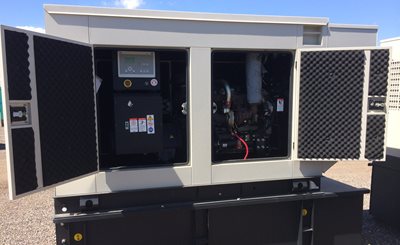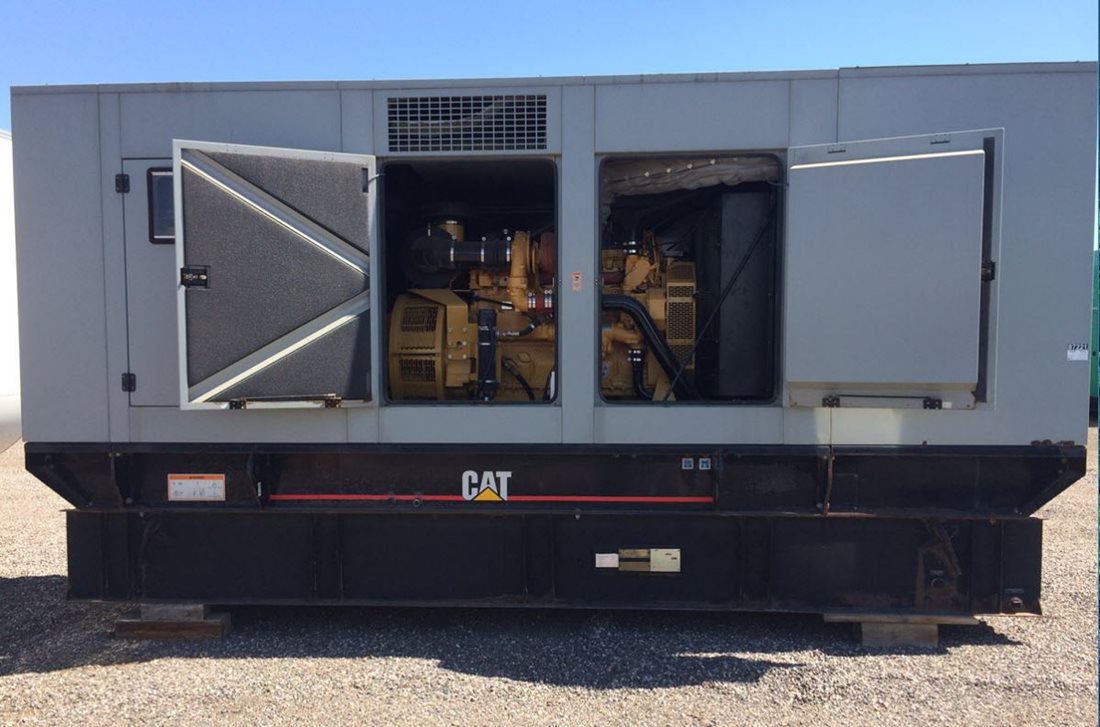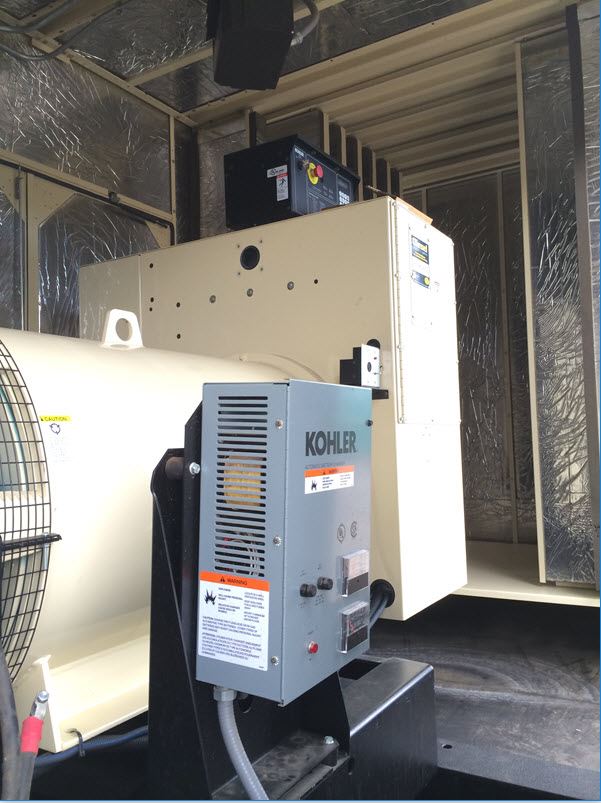
Many industries require backup power. These high-tech industries are often located in or close to a city or residential area. Both State, Local and Occupational Safety and Health Administration (OSHA) sound guidelines must be followed when selecting a generator set. Sound is generally measured at the property line of the facility. The maximum permitted overall noise levels range from 45 to 72 dB(A). Each area has specific requirements that must be met.
What is Noise
Sound is produced when an object vibrates in open air. The vibration emits pressure waves into the air. Sound can become painful, uncomfortable or annoying when the amplitude of the pressure wave exceeds the threshold level. The dB scale defines the level of sound. There are two dB scales:
- dB(L) – Measurement derived on a linear scale. This scale treats all frequencies as an equal value. The ear is sensitive to ranges between 1,000 to 4,000 Hertz per seconds.
- dB(A) – Measurement of sound derived from what the human ear hears. The scale is weighted and more accurately reflects what the human ear perceives. In 1972 OSHA adopted the dB(A) as the official sound measurement.
Sound levels from 80 to 100 dB(A) are considered to be very loud, 100 to 125 dB(A) uncomfortable, and 140 dB(A) reaching the threshold of pain. For more information on the basics of sound attenuation and sound absorbtion materials, view our additional article
here.
Measuring Sound
Microphones are placed approximately 23’ from the enclosures at 45°angles. Up to eight octave bands can be tested. These bands are divided into the frequencies the ear is sensitive to. The sum of the eight tests is the most important information when determining total noise.
Commonly eight tests are completed at eight octave bands (frequencies). The tests measure the ambient noise for each octave band at the property line without the generator set running (this portion, defines ambient sound). The tests requie that teh generator sets are started and run at full load and repeat the measurements for each desired octave band.
Reducing Generator Set Noise
There are a few concepts to follow when reducing a generator set noise. Generator set manufactures use these concepts when designing sound-attenuating enclosures:
- Acoustic Barrier – Enclosures constructed of steel panels. Electrical, fuel pipes and any other auxiliary entries must be sealed.
- Acoustic Insulation – Sound absorbing insulation in/on interior panels.
- Isolation Mounts – Generator, engine and auxiliary support components are connected using isolation mounts.
- Cooling Air Attenuation – Baffles installed into air intake louvers.
- Exhaust – Style of muffler installed is significant. Choose muffler that meet state and local requirements.
- Enclosure Location – Locate enclosure as far from property line as possible.
The above information was acquired from Generator Set Noise Solutions white paper. For additional information on Cummins enclosures, view this
informational PDF.
Cummins Sound-Attenuated and Weather Protective Enclosures
Cummins offers sound-attenuated enclosures (Figure 1) in three different levels. Each level offers a different level of sound output during operation. The three levels of sound-attenuation are:
- Level I – Generator operates at 70 to 89 d(B)A
- Level II – Generator operates at 63 to 78 d(B)A
- Level III – Generator operates at 68 to 70 d(B)A
All three levels of enclosures incorporate:
- Low profile design and easy access to all major components.
- Engine, generator set, muffler and controls are housed in enclosure.
- All steel construction with stainless steel hardware mounted to sub-base fuel tank or lifting base.
- UL220-Listed.
Upgrade options available are:
- Enclosure wind rated to 150 mph
- Kits to upgrade existing sound attenuated enclosures to next sound level
- Exterior oil and coolant drains with interior valves
- Overhead two point lifting brackets on some models
The above information was acquired from Sound-attenuated and weather-protective enclosures. For additional information on Cummins enclosures, view this
informational PDF.
9fe1.jpg)
Figure 1, Cummins Enclosure
Caterpillar Weather Protective and Sound Attenuated Enclosures
Caterpillar offers sound-attenuated enclosures (Figure 2) in three different levels. Each level offers a different level of sound output during operation. The three levels of sound-attenuation are:
- Weather Proof Industrial – Depending on size, generator operates at 84 to 98 d(B)A
- Level I – Depending on size, generator operates at 78 to 95 d(B)A
- Level III – Depending on size, generator operates at 78 to 91 d(B)A
All three levels of enclosures incorporate:
- Single side access for service and controls. Removable doors and panels. Double lockable doors on both sides
- Stainless steel flush fitting latches. Zinc plated or stainless steel fasteners
- Body made of 16 gauge steel components
- Exterior oil and coolant drains
Upgrade options available are:
- Enclosure IBC certifiable to120 mph.
- Cat yellow or white paint.
- Seismic certifications
- Overhead two point lifting brackets on some models.
- UL Listed sub base tanks.
The above information was acquired from Weather Protective and Sound Attenuated Enclosures. For additional information proceed to
Cat-ElectricPower.com.

Figure 2, Caterpillar Enclosure
Kohler Weather and Sound Enclosures
Kohler offers sound enclosures (Figure 3) in three different levels. Each level offers a different level of sound output during operation. The three levels of sound-attenuation are:
- Steel Weather Enclosure – Depending on size, generator operates at 71 d(B)A @ 23’
- Steel Sound Enclosure – Depending on size, generator operates at 70 d(B)A @ 23’
- Aluminum Sound Enclosure – Weight reduced. Depending on size, generator operates at 70 d(B)A @ 23’
Steel weather enclosures feature:
- Engine, generator set, muffler and controls are housed in enclosure
- Skid mounted steel construction with power armor automotive grad finish
- Easy access doors
- Enclosure wind rated to 150 mph
Sound enclosures have all features or weather enclosures, with the additions of:
- Constructed with sound attenuation material
- Skid mounted on aluminum or steel. Aluminum is recommend for high humidity regions
- Acoustic insulation meets UL 94 HF1 flammability classification
The above information was acquired from Kohler Power Systems Weather and Sound Enclosures.
 Figure 3, Kohler Enclosure
>>Back to Articles & Info<<
Figure 3, Kohler Enclosure
>>Back to Articles & Info<<